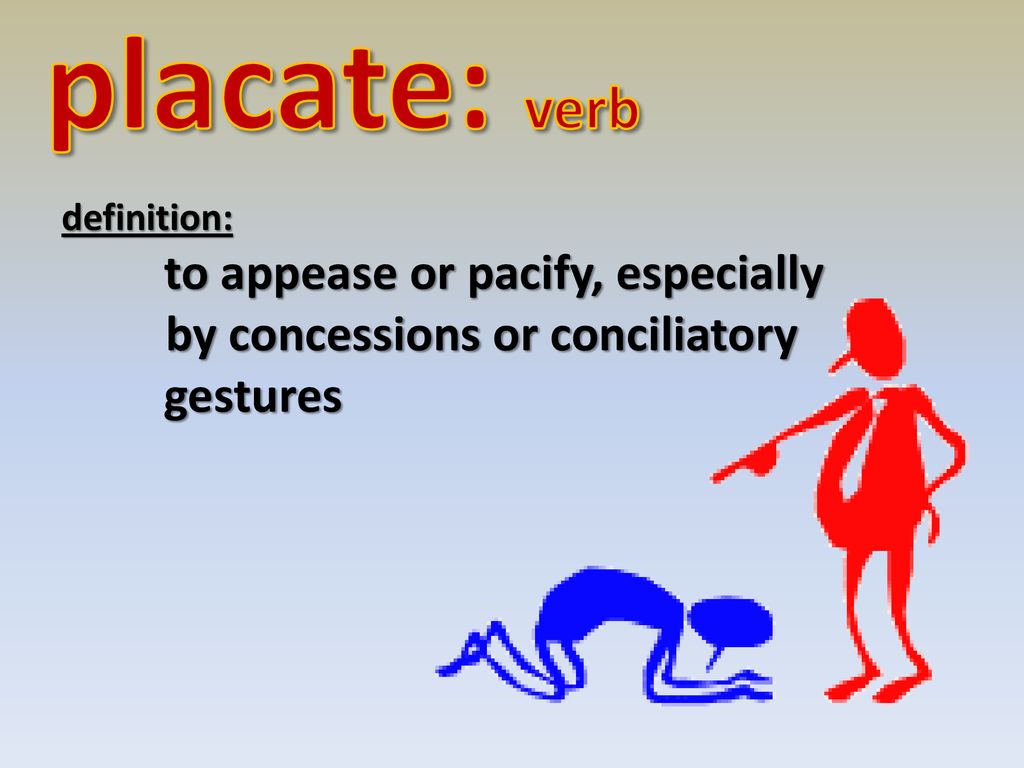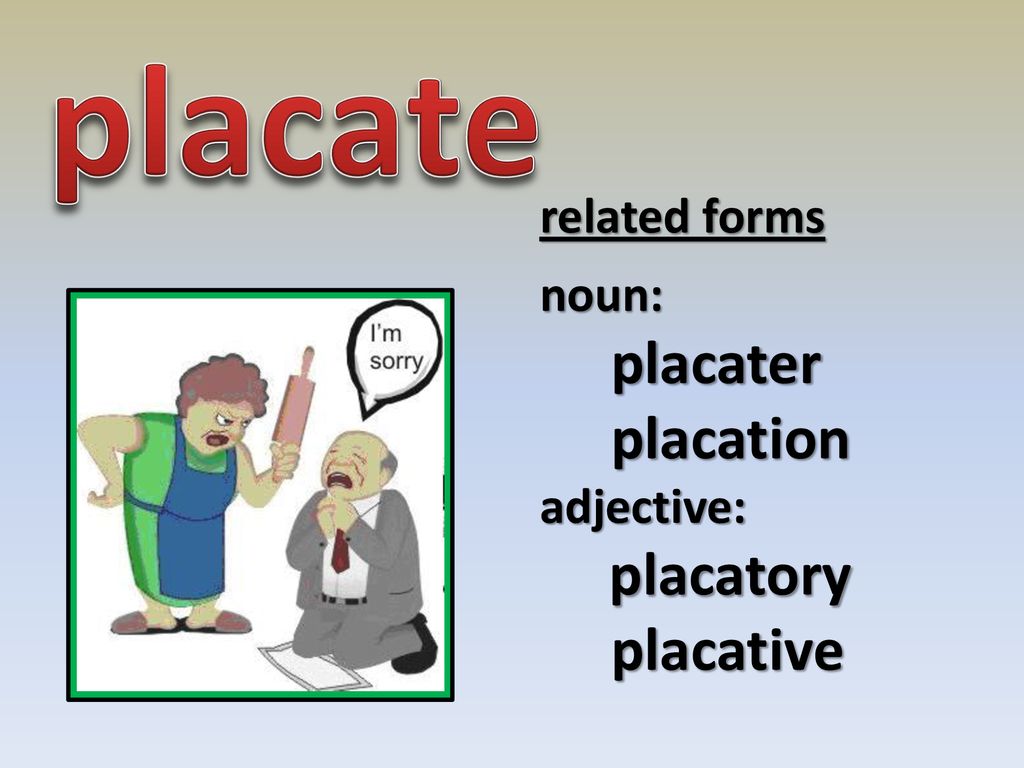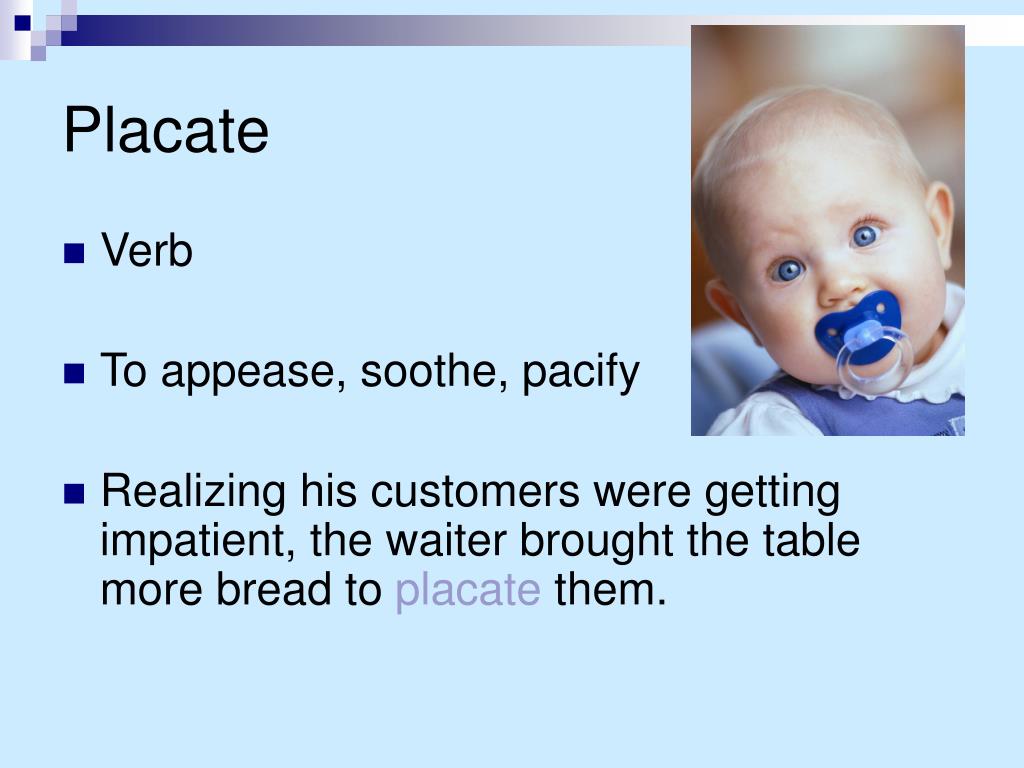Placate Meaning - What It Really Means
Have you ever found yourself in a moment where someone was really upset, perhaps quite cross, and you just wanted to make things better? Maybe you offered a warm drink, or perhaps you just listened with a patient ear. That very feeling, that act of trying to calm someone down and bring them back to a more settled state, is at the very heart of what we talk about when we discuss the idea of "placate meaning." It's about easing strong feelings, making someone feel less agitated, and bringing a sense of quiet to a ruffled situation.
It’s a word that comes up a lot, you know, when people are talking about how to handle tricky interactions. We often hear it in conversations about smoothing things over, or, say, making someone who is really bothered feel a bit more at peace. This isn't just about saying sorry, or just giving in, but rather about taking steps to make a person or even a whole group feel more agreeable, less ready to argue or be upset. So, in a way, it’s about finding a path to peace, or at least a path away from conflict.
The idea behind "placate meaning" shows up in so many parts of our day-to-day existence. From dealing with a little one who is having a big outburst, to situations where businesses need to make things right for unhappy patrons, or even when those in charge of a country need to address what their people are feeling. It’s all about finding ways to lessen anger or strong negative feelings, often by offering something helpful or doing something pleasing. It’s a useful concept to keep in mind, really, for anyone looking to handle difficult emotional moments.
Table of Contents
- What Does It Mean to Placate Someone?
- The Core of Placate Meaning
- When Do We Try to Placate?
- Placate Meaning in Everyday Situations
- How Does Placate Meaning Show Up in Larger Groups?
- Placate Meaning and Public Feelings
- Is There a History to Placate Meaning?
- The Past of Placate Meaning
- Understanding the Nuances of Placate Meaning
- Placate Meaning - Beyond Just Stopping Anger
What Does It Mean to Placate Someone?
When you set out to placate someone, you are, quite simply, trying to bring them a sense of calm. Think about it: someone is feeling a great deal of frustration, or maybe they are just really, really mad. Your aim, in that moment, is to make them feel better, to take away that strong upset feeling. This often involves giving them something they want, or doing something that makes them happy, so that their bad mood begins to lift. It’s about making an effort to turn a frown upside down, or at least to soften the edges of their irritation.
The Core of Placate Meaning
The core idea of "placate meaning" really revolves around soothing someone. It’s like gently calming a ruffled feather, or pouring oil on troubled waters. The goal is to lessen the anger, or to make someone less hostile. This might happen by offering a small gift, or perhaps by making a promise that helps them feel more secure. For instance, if a customer is quite unhappy with a service, a business might try to placate them by giving them a refund or a special discount. This action is meant to win back their good feelings and make them feel heard and valued. It’s a way of making someone content, or at least no longer completely furious.
When Do We Try to Placate?
We try to placate people in all sorts of situations where strong feelings are involved. Imagine a child who is crying because they can’t have a certain toy. A parent might try to placate them by offering a different, equally interesting toy, or by distracting them with a fun game. The aim is to shift their attention away from what is making them upset and bring them to a more cheerful state. It’s about finding a way to make the person feel better, to stop their distress, and to help them move on from the moment of upset.
Placate Meaning in Everyday Situations
The idea of "placate meaning" comes up quite often in our daily lives, you know. Think about those times when you might accidentally upset someone you care about. Perhaps you forgot something important, or said something without thinking. To make amends, you might try to placate them. This could mean saying a sincere apology, or perhaps doing a kind gesture that shows you care and want to make things right. For example, if you upset a friend, you might offer to treat them to their favorite coffee, just to show you’re sorry and want to smooth things over. It’s about making an effort to bring someone back to a good mood.
Another common example is when a company faces a lot of complaints about a product or service. To placate the unhappy customers, they might offer something extra, like a free upgrade or an extended warranty. This action is meant to calm their frustration and regain their trust. It’s a very practical way to deal with dissatisfaction, really, by addressing the source of their upset with something they find valuable. The goal is to turn their bad experience into something a bit more positive, or at least neutral.
How Does Placate Meaning Show Up in Larger Groups?
The concept of placating isn't just for one-on-one interactions; it also applies to larger groups, like communities or even whole populations. When people are feeling restless or angry about something, those in charge often look for ways to ease their concerns. This might involve making changes to certain rules or policies, or perhaps offering something that directly addresses their complaints. It’s about trying to make a large number of people feel better about a situation, especially when they are feeling quite agitated.
Placate Meaning and Public Feelings
When we look at "placate meaning" in a broader sense, it often relates to how leaders or governments respond to public discontent. For instance, in times past, if people were very unhappy about restrictions on what they could say or write, those in power might have tried to placate them. This could involve making those restrictions less strict, or even getting rid of them completely, as a way to calm the public’s anger. It’s a strategic move, basically, to prevent bigger problems by making concessions.
Similarly, if a large group of people were struggling with their daily needs, efforts might be made to placate them by addressing those very needs directly. This could mean providing food, or perhaps ensuring better living conditions. The idea is to make the people feel that their concerns are being taken seriously and that something is being done to help them. It’s a way of influencing those who are feeling furious to become more content, or at least less upset, by showing that their material well-being is being considered.
Is There a History to Placate Meaning?
The word "placate" has been around for a good while, and its core sense of calming or soothing someone has remained pretty consistent. When you look into its past, you find that it has always been used to describe the act of making someone less angry, often by giving them something they want or by doing something to please them. It’s a concept that has been useful for a long time, across different situations where people need to manage strong emotions.
The Past of Placate Meaning
If you look at the origins of "placate meaning," you see that it comes from a sense of making things peaceful. It’s about bringing quiet to a noisy situation, especially when that noise is caused by anger or strong displeasure. The way it has been used through time, in various texts and discussions, consistently points to this idea of calming someone down. It’s about gaining someone’s good feelings back, or preventing them from becoming even more upset. So, in a way, it’s a word that speaks to the very human need to resolve conflict and restore a sense of calm.
Understanding the Nuances of Placate Meaning
While the basic idea of "placate meaning" is about making someone less angry, there are a few subtle points to keep in mind. It often implies that the person being placated is receiving something, or that an action is being taken specifically to address their upset. It’s not just about waiting for someone to calm down on their own, but actively doing something to help that process along. This distinction is quite important when you are trying to use the word accurately.
Placate Meaning - Beyond Just Stopping Anger
The act of placating someone goes a bit beyond just stopping their anger. It’s also about influencing them, you know, to move from a state of being furious to one where they are, at the very least, no longer feeling so irate. It’s about turning a very negative emotional state into something more neutral, or even positive. This might involve a smile, a kind word, or a specific action that shows you are trying to make things right. The goal is to bring them to a point where they feel content, or at least where their strong negative feelings have faded. It’s a way to soothe someone, truly, and help them feel better about the situation.
So, when you consider "placate meaning," think of it as a tool for managing emotional friction. It’s about taking steps to make someone who is feeling upset feel less angry, often by offering something they desire or by doing something to please them. This could be a small gesture in a personal moment, or a significant action taken by a larger entity to address widespread unhappiness. The word really captures the essence of trying to restore peace and good feelings in a challenging situation.

placate: verb by concessions or conciliatory gestures definition: - ppt

Placate Definition

PPT - Vocabulary Unit 11 PowerPoint Presentation, free download - ID